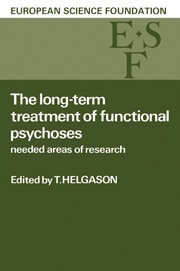Book contents
- Frontmatter
- Contents
- List of Participants
- Introduction
- I Organisational Aspects of Long-term Treatment
- II Patients Aspects of Long-term Treatment
- III Public Health Aspectsof Long-term Treatment
- Introduction to public health aspects of chronic illness and long-term treatment
- Evaluation of long-term community care for patients with schizophrenia
- Case registers for monitoring treatment outcome in chronic functional psychoses
- Socialdisabilityand chronicmentaldisorder
- The neglect of the patient with chronic functional psychosis: the need for further research
- Suicidesand functional psychoses
- Interaction with families
- Cost-effectiveness analysis
- Consumption of services-European aspects
- Index
Interaction with families
from III - Public Health Aspectsof Long-term Treatment
- Frontmatter
- Contents
- List of Participants
- Introduction
- I Organisational Aspects of Long-term Treatment
- II Patients Aspects of Long-term Treatment
- III Public Health Aspectsof Long-term Treatment
- Introduction to public health aspects of chronic illness and long-term treatment
- Evaluation of long-term community care for patients with schizophrenia
- Case registers for monitoring treatment outcome in chronic functional psychoses
- Socialdisabilityand chronicmentaldisorder
- The neglect of the patient with chronic functional psychosis: the need for further research
- Suicidesand functional psychoses
- Interaction with families
- Cost-effectiveness analysis
- Consumption of services-European aspects
- Index
Summary
Background
A series of studies has established a strong and replicable relationship between certain emotional attitudes of family members and the outcome of schizophrenia over a period of up to 2 years (Brown et al., 1962; Brown, Birley & Wing, 1972; Vaughn & Leff, 1976a; Leff & Vaughn, 1981). To date, this relationship has been established only in the AngloSaxon cultures of England and the west coast of America. In these English-speaking samples, the key emotional attitudes of relatives that predict relapse of schizophrenia are criticism and over-involvement. In both the London and California studies, if relatives made six or more critical comments in the course of the interview or scored three or above on the over-involvement scale, the relapse rate for schizophrenia was more than 50% over 9 months. Relatives with scores of this magnitude are categorized as high on expressed emotion (EE). Patients who live with high EE relatives have significantly lower relapse rates if they take regular maintenance anti-psychotic medication or if they are in low face-to-face contact with the relatives, that is, they keep out of their way.
The effectiveness of prophylactic medication is now well established but, until recently it was not known whether the association between high EE and schizophrenic relapse reflected a causal connection; nor was it known whether low face-to-face contact was genuinely protective. Two controlled trials of social intervention in the families of schizophrenic patients living with high EE relatives have been published recently (Falloon et al., 1982; Leff et al., 1982). One trial was carried out in California and involved a behavioural approach to working with the families (Falloon et al., 1982). The other took place in London and evaluated a package of social treatments, including mental health education of the relatives, a relatives' group and family therapy. In both trials, patients were maintained on prophylactic medication. Despite the differences in venue and therapeutic approach, the results of the two trials were remarkably similar. In the California study the relapse rates for the experimental and control groups over 9months were 6%and 44%respectively, while the comparable figures in the London study were 8% and 50%. Taken together, these results provide evidence for a causal role of relatives’ EE in schizophrenic relapse.
- Type
- Chapter
- Information
- The Long-Term Treatment of Functional PsychosesNeeded Areas of Research, pp. 241 - 246Publisher: Cambridge University PressPrint publication year: 1985

